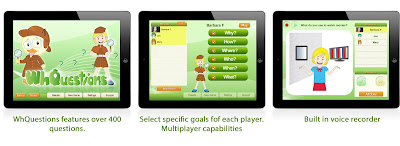On the 7th day of posting this Speech Lady gave to me, some apps that are freaking awesome!
Custom Boards
On the main page you can choose from a number of pre-made templates (over 100 templates). The templates include game and activity boards, boards that go along with AAC devices, an option to make signs and labels, schedules and calendars, worksheets and custom grids and boards.
Here are some examples of the game boards I've created.
Pick your game board theme, then decide what pictures you want in each circle. Custom Boards has a huge amount of pictures in their picture dictionary to choose from AND if you can't find the right image then there is a direct link to google to search for pictures. Once you have selected all your pictures you can email it to yourself as a PDF, print or save to your photo library. Here are some examples:
If you are making pages for devices or switches, Custom Boards gives you the option to choose from 33 different AAC devices and switches. I've made several Go Talk pages from this app.
The signs and label option is great for making visuals for you classroom. It has an option to make something as simple as labels for boxes to traffic symbols and speech bubbles.
The Calendar option is great for your kids that need visual schedules. You can make custom schedules so easily it would be silly not to! Here is an example of a first/then schedule I made.
The Worksheets option has a lot of great visuals to use with any activity. There are worksheets for sequencing, making small books, before and after, sorting and other themed worksheets.
All in all I really love this app. It takes all the hard work out of making homework sheets, class activities, schedules etc.
You can buy Custom Boards here for $39.99. I really think this one is worth the price!
The next app is also from Smarty Ears and it's called Wh- Questions.
This app allows you to have multiple students saved and you can hand pick based on that child's goals what type of questions are asked. Most if not all of the students I've worked with that have a language disorder or delay have some kind of wh-question goal. Wh-questions can be targeted in a number of ways, but this app has engaging pictures that help keep the attention of the child.
My suggestions for future versions of this app would be the ability to pick and choose what questions are asked as well as the difficulty. It would be great if the questions had a multiple choice option where the children could use visuals to answer the question. Because my students are so little, the visual representation of answers is key in their ability to be successful. I do really like this app for progress monitoring. Every couple weeks go through and see the gains the child has made towards their goals.
All in all this app is interactive and engaging.
You can buy it here for $9.99
Thanks Smarty Ears for your generosity to Speech Lady Liz.
*Disclaimer: Smarty Ears provided me with a code to review product. No other compensation was provided. The opinions expressed are that of Speech Lady Liz.





















